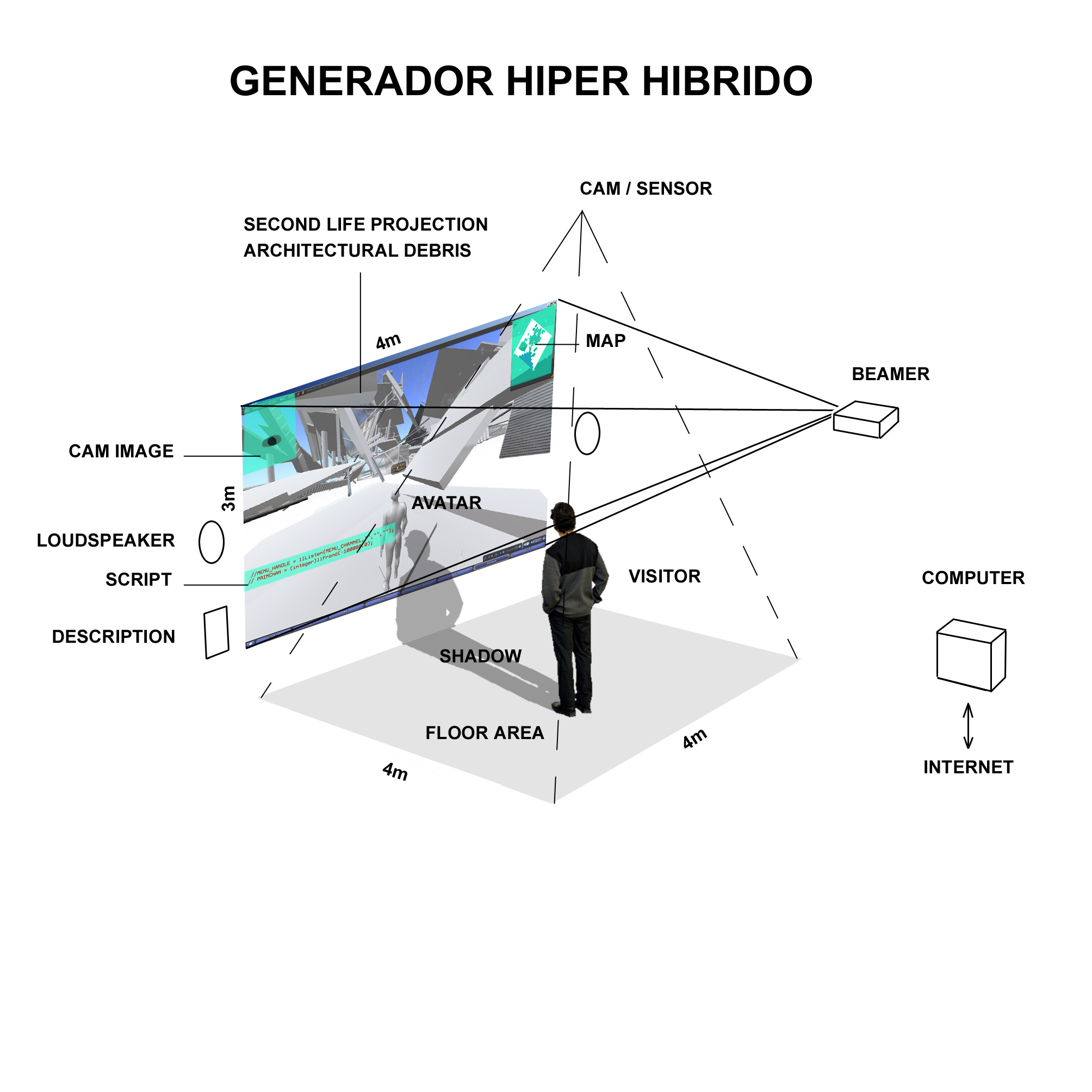 |
 |
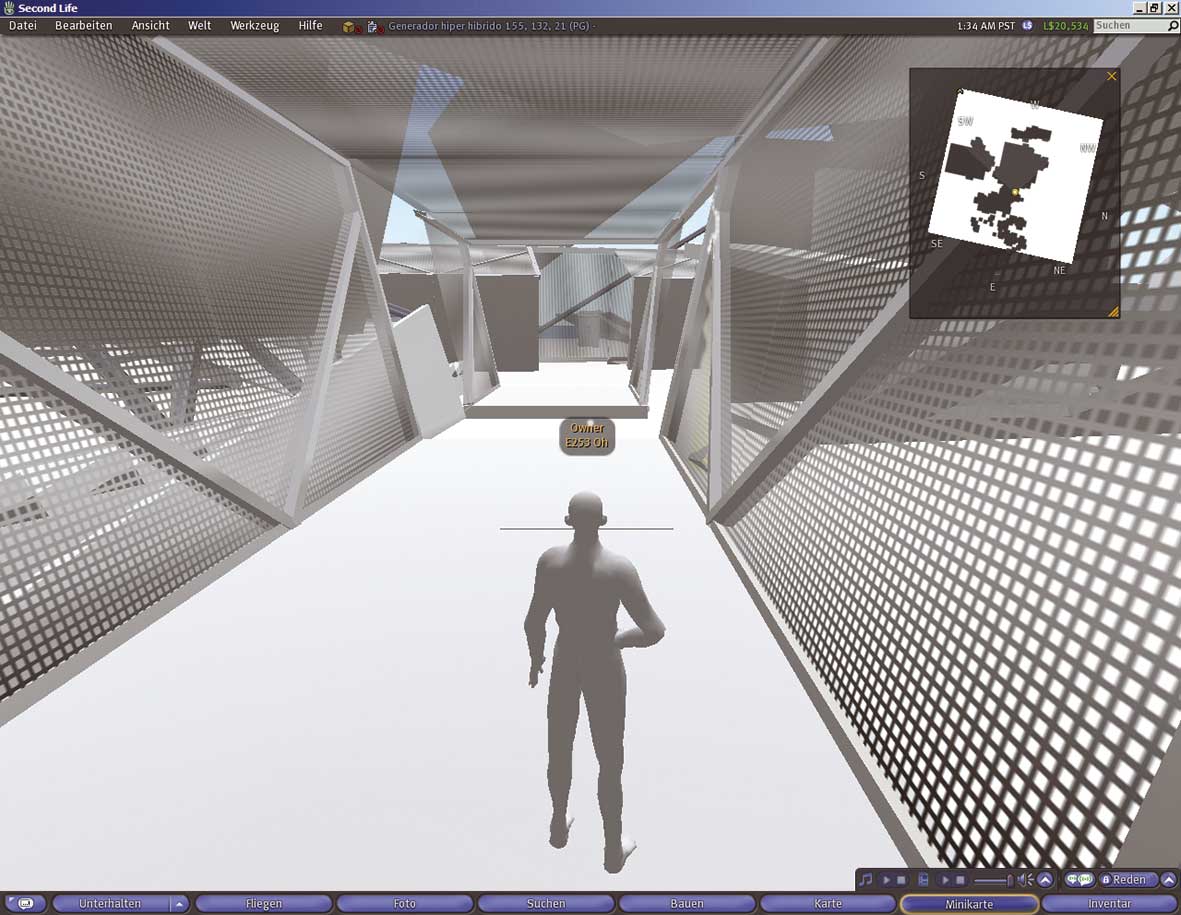 |
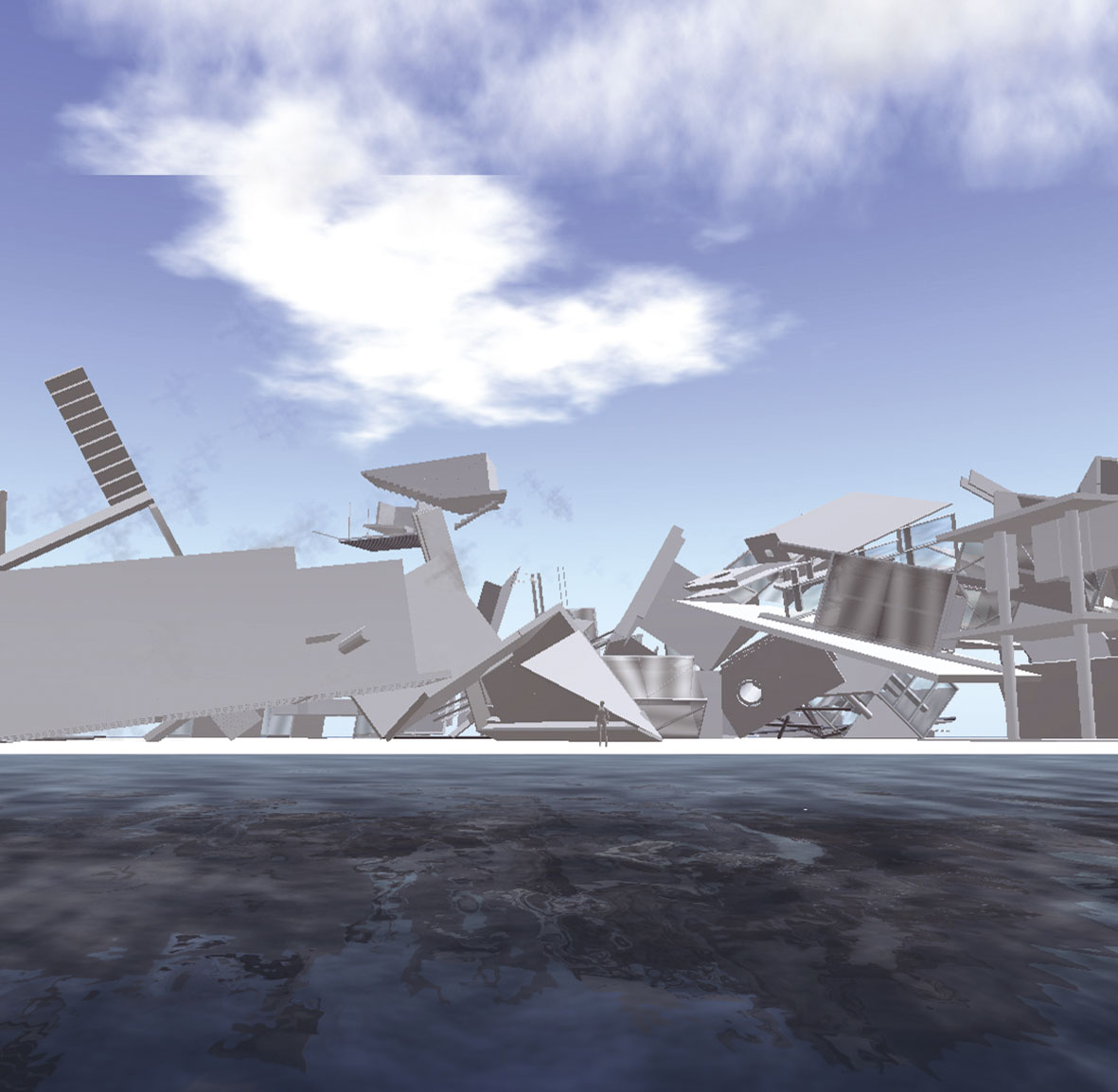 |
|
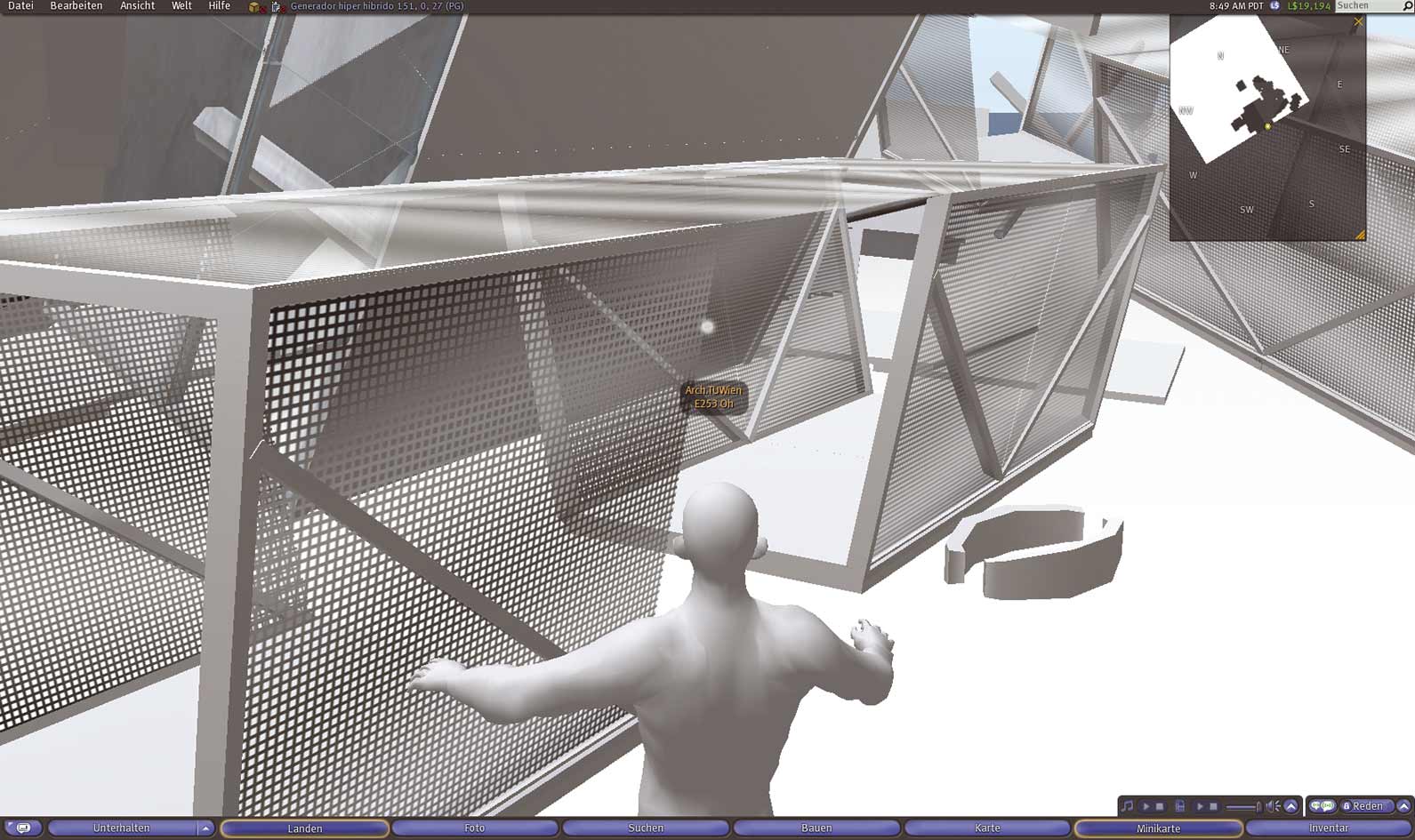 |
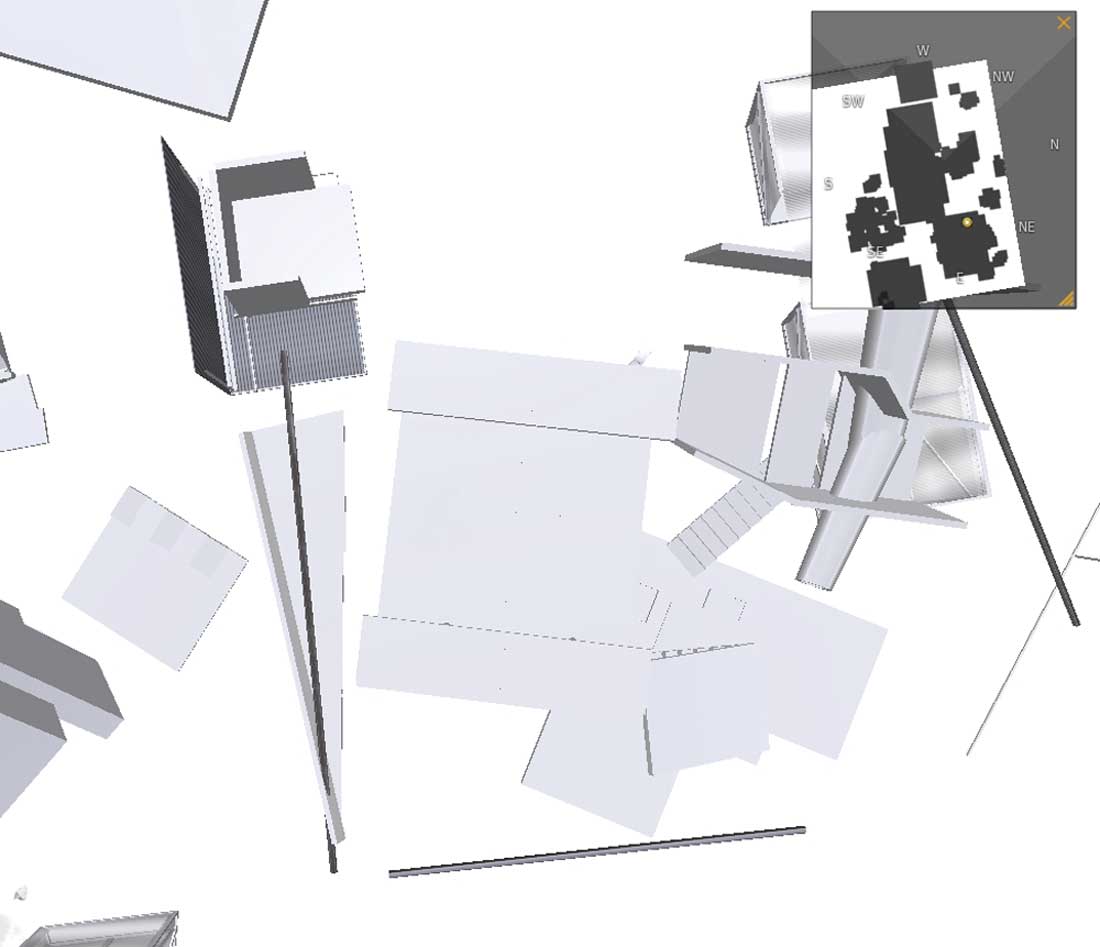 |
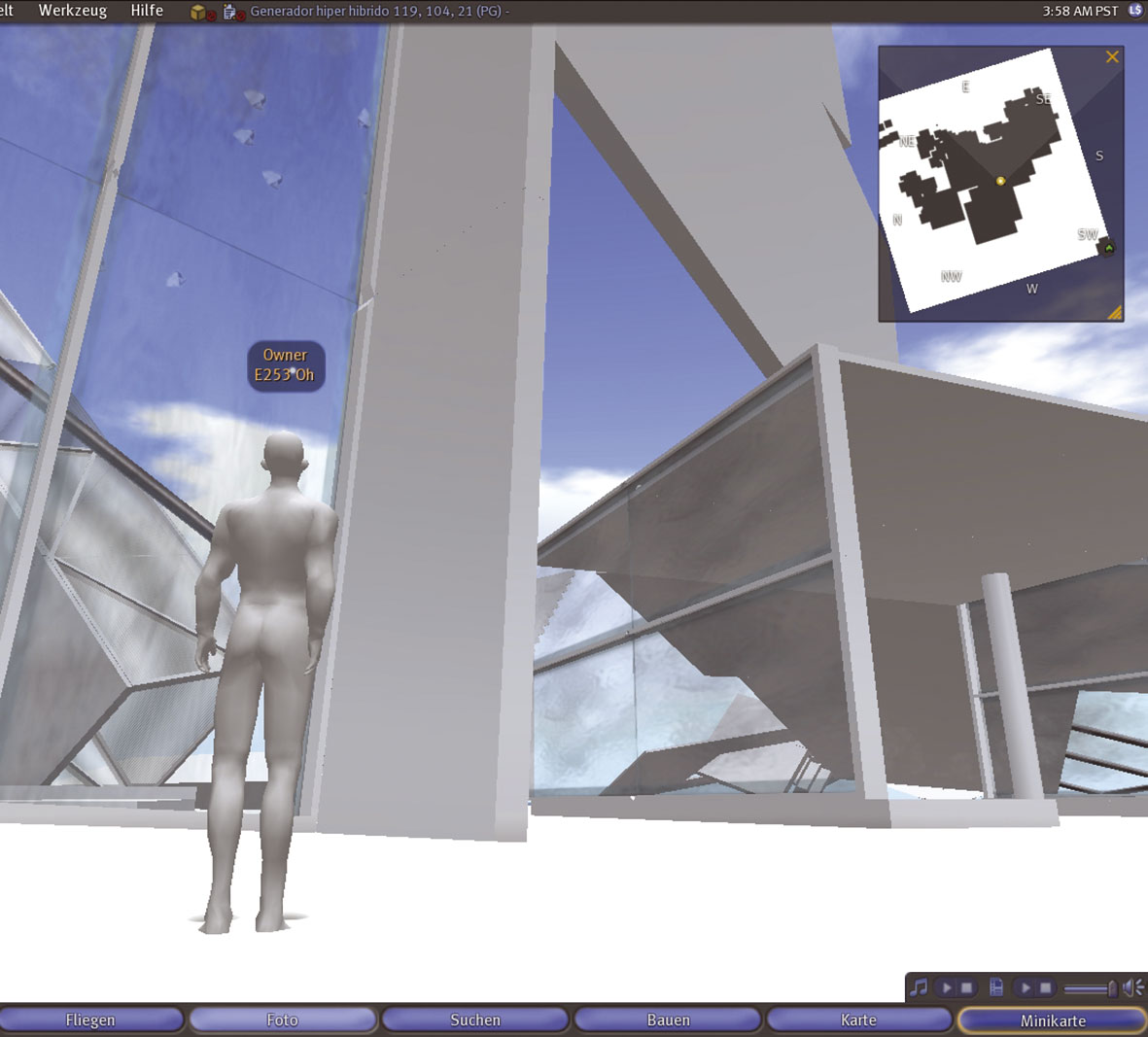 |
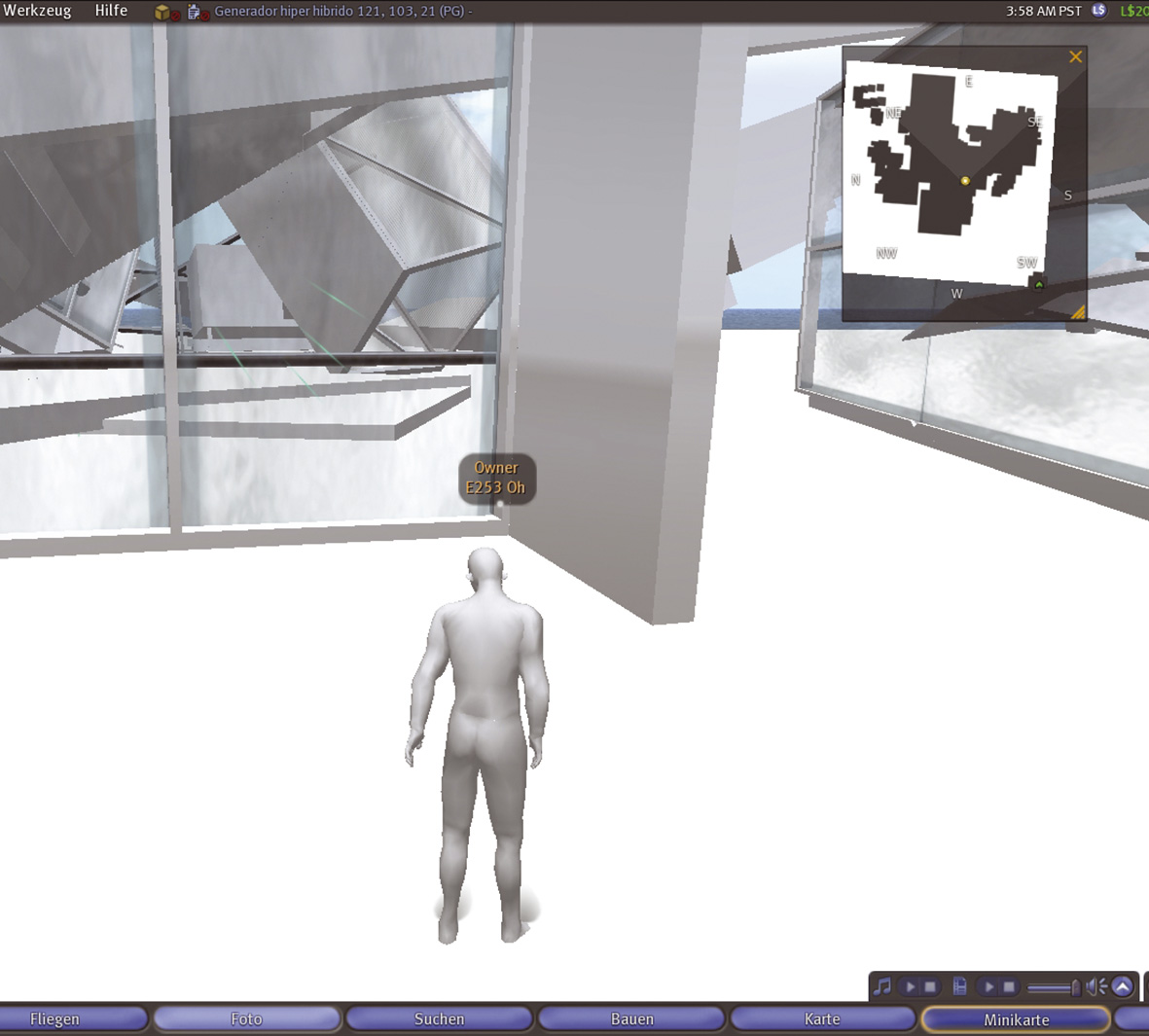 |
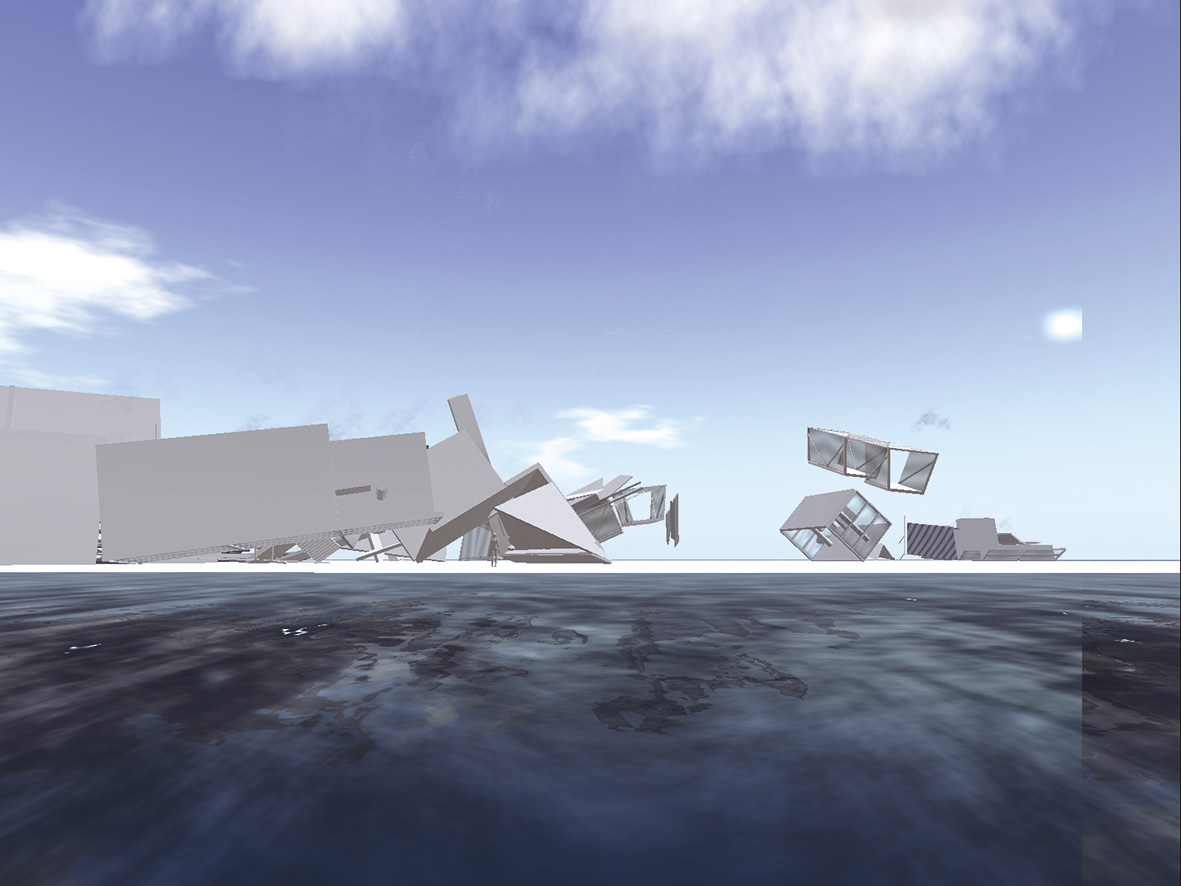 |
| Generador Hiper
Hibrido by Manfred Wolff-Plottegg already 2008 |
Installation
for BIACS 3 |
|
| Link SL Generador Hiper Hibrido |
Deutsch lang english entire version / english shor |
movie >>>>> hyper_hybrid_generator.mp4

movie
>>>>> hyper_hybrid_install.mp4
Hyper_Hybrid_Generator
Second Life:
The BIACS3 installation:
As soon as a visitor to the exhibition in Seville enters into the floor area of the installation (representing the island) he will be captured by a video cam, his movements will be recalculated by means of video-tracking (instead of the algorithmic movements) and will then control the avatar in an analogue manner. The avatar enters into the projection field, becoming visible on the island (third-person perspective). Just as the visitor controls himself (his own movements) he controls the avatar and his own moving shadow. Additionally the superimposed images of the video camera and controlling script are visible.
So the installation shows in one configuration a total of five different representations / appearances / aggregate states of the visitor in Second Life.
Scripting
description:
The Hyper_Hybrid_Generator is a
script embedded into the multi-user virtual environment Second Life. The script
utilizes the basic code of Second Life and offers a new form of morphing: it
simulates common architectural design processes in which usually debris of
memories/desires/dreams initiate new architecture.
The hyper-hybrid design script generates architectural hybrids. By randomly selecting and assembling various elements of the input it returns a hybrid. The input elements could be architectural debris. They fall onto the island:
for( i = (integer)llFrand(giMax - giMin) + giMin; i >= 0; i-- ) {
objName = llGetInventoryName(INVENTORY_OBJECT, (integer)llFrand(i));
llRezObject(objName, vThisPos, ZERO_VECTOR, <llFrand(360.0),llFrand(360.0),llFrand(360.0),llFrand(1.0)>, giSyncID);
}
Out of the total quantity of all the pieces that are provided by the available components the parent object generates a random amount of architectural debris. The components are born one unit below the current position of the parent object with a pseudo-random rotation.
state_entry() {
gintHandle = llListen(gintPrimChan, gstrCommander, NULL_KEY, "");
llSetStatus(STATUS_PHYSICS,1);
}
After its generation the component – the child – awaits commands from the parent object and applies the physics simulation engine.
integer iHops = llAbs(llCeil(llVecDist(llGetPos(), gvDestPos) / 10.0));
for( x = 0; x < iHops; x++ ) lParams += [ PRIM_POSITION, gvDestPos ];
llSetPrimitiveParams(lParams);
The child calculates the position of the collision with the simulated world and / or with other components and quantifies the path to follow.
if (gvDestPos == llGetPos()) llSetStatus(STATUS_PHYSICS,0);
The component / child has not moved since its last quantification and has successfully made its path. In order to repel further influences from outside, the child leaves the physics simulation engine and stays in this position until deletion.
The installation at the BIACS shows how the Hyper_Hybrid_Generator processes architecture. The visitor of the installation is tracked by a webcam and thus becomes part of the interactive setup: in this setup the avatar is similar to a cursor pretending to be a kind of alter ego of the visitor (his perspective view). The virtual island /
SL Generador Hiper Hibrido / can be visited from anywhere (as usual in Second Life).
Software
team:
Jochen Hoog, Lukas Ofner, Johannes
Sperlhofer, Manfred Wolff-Plottegg / Technic University
Vienna
p.s.: Don’t be annoyed with the
(deconstructive) forms. Any shape – generated, invented, anticipated or designed
– could be taken as input.
Instructions for the installation:
Mark out the floor area (approx. 4m x 4m), this square should be a relatively grey (white) area on the floor.
Fix the video cam (= motion detector) above this square; the field of view of the cam should not touch the projection area (wall).
Adjust the beamer to project onto the wall. A visitor on the floor area should cast a shadow on the screen.
Connect the PC to the internet.
Connect the beamer.
Connect the loudspeaker.
Hide keyboard and mouse (not accessible for visitors)
Hide PC (not accessible for visitors)
Switch on the PC, the webcam and the beamer:
When booting the PC, all necessary programs run automatically (start WinXps, start task manager, start cam / motion detector, start explorer, start SL, logging into the SL- Generador hiper hibrido island, getting the start position / vehicle, etc.) and finally the Generador hiper hibrido is working in SL.
!!!!! During this booting procedure do not move the mouse or the keyboard !!!!! !!!!! This booting procedure takes several minutes !!!!! !!!!! Do not react to the pop-ups on the screen !!!!!
Das Institut für Architektur und Entwerfen, Abteilung für
Gebäudelehre und Entwerfen, untersucht in computergestützten Entwürfen Fragen
der aktuellen Entwicklungen in der Architektur. Im Vordergrund stehen dabei die
Funktionen. Indem im Planungsprozess – mit Methoden höherer Ordnung – auf
web-basierte Informations- und Kommunikationstechnologien zugegriffen wird,
werden einerseits im Entwurf neue Architekturen produziert, andererseits ein
neuer und erweiterter Zugang zu computerbasierten Methoden für die Planung von
Architektur entwickelt. Die Grundlagen der Architektur-Algorithmen werden
planungstechnisch bis hin zum End-User-Scripting ausgeweitet. Architektur und
Computer und WWW werden gleichermaßen als Medien der Informationsverarbeitung
gesehen, sie sind Informationseditoren.
Die Theorie zu diesem Management der Planung wurde im Buch HYBRID ARCHITEKTUR &
HYPER FUNKTIONEN (Passagen Verlag 2006) publiziert. Die Installation HYPER
HYBRID GENERATOR wurde von Univ.Prof. Manfred Wolff-Plottegg und Univ.Ass.
Jochen Hoog (Fakultät für Architektur und Raumplanung – TU Wien) fakultäts- /
spartenübergreifend mit den Programmierern Lukas Ofner und Johannes Sperlhofer
(Studienassistenten, Fakultät für Informatik – TU Wien) entwickelt und erstmals
auf der Biennale in Sevilla 2008 vorgestellt. Auf der Plattform des Second-Life
werden permanent sich erneuernde random-Architekturen, 3D-Modellierungen
generiert. Durch das Potential des Second-Life als Kommunikations-plattform
werden über das übliche Visualisieren und Surfen hinaus Abläufe simuliert.
Das ausgeweitete Umfeld der
Planung:
Es geht um Planung, Planungsabläufe, Planungsmethoden,
Grundlagen der Planung, Planungsmanagement, Planung n-ter Ordnung, das Planen
der Planung, somit um Projektsteuerung.
Der traditionelle Planung ist bemüht die Zuordnung Bedarf > Erfüllung zu
bedienen: Dem vorgegebenen Raumprogramm folgt die Funktionserfüllung. Jeder
gekapselten Funktion ihre lineare Zuordnung! ..... die Küche zum Kochen .....
das Bett zum Schlafen im Schlafzimmer ..... die Wohnung in der Wohnsiedlung ….
Staubsauger zum Saugen …. Der spezifizierten Zieldefinition muß eine optimierte
Umsetzung ohne Abweichung entsprechen. Das Planungsverhalten ist
deterministisch: heute planen > morgen betonieren > möglichst lange nutzen
(Nachhaltigkeit). Diesem Paradigma entspricht eine Architektur der starren
Objekte (der Formen, der Proportionen, der Angemessenheit) und die
Funktionstrennung.
Die Realität der alltäglichen Nutzung, die laufenden Änderungen in den
Anforder-ungen und Verschiebungen in den ökonomischen Randbedingungen machen das
Insistieren auf einmal getroffene Entscheidungen (Entwürfe) obsolet. Eine
Architektur der Veränderungen, das Potential einer prozeßhaften Architektur ist
gefordert. In der prozesshaften Architektur werden nicht länger deterministisch
definierte Objekte produziert, sondern Vorgänge, Funktionsabläufe und
veränderungen simuliert.
Der Blickwinkel im Projektmanagement der Architektur, speziell die
Funktionslehre hat sich neu kontextualisiert, geändert, geöffnet. Nach dem
Paradigmenwechsel vom Determinismus zum offenen System beschäftigt sich die
Architektur nicht mehr mit sich selbst (Funktionserfüllung, Material, Form),
sondern operiert mit Planungsprozessen und formuliert Architektur als
prozeßorientiert. Das Produkt / Objekt / Gebäude wird relativiert, das Verfahren
selbst (Produktionsmethoden, Einbeziehen der Produzenten, der Nutzer und der
ausgeweiteten Bezugfelder) wird prozesshaft neu entworfen. Anstelle der
Optimierung von Räumen für eine spezifische Funktion werden Verfügungsbauten
organisiert. Verfügungsbauten setzen die Realität einer sich ständig ändernden
Nutzung um. Insofern stehen nicht starre Gebäude, sondern vielmehr hybride
Nutzungen als Funktion der Architektur im Vordergrund.
Auch der Städtebau beschäftigt sich heute gezwungener Maßen mit Prozeßsteuerung, Architektur ist nicht mehr Gebäude oder Objekt, Urbanismus nicht Funktion sondern Organ. Wir können gezielt den Aspekt Architektur als Medium (sehr langsam) und als Prozeß forcieren, und eine Architektur der Beschleunigung betreiben. Somit wird klar, daß diese avancierte Architektur relativ wenig mit dem persönlichem Gefallen (abgestimmt mit Bauch und Hirn) zu tun hat, viel eher mit „externen“ Abläufen und globaleren Systemvariablen: Produkt > Werkzeug > Werkzeugmaschine > Programm > Programmsteuerung > Systemsteuerung ...... Nach Ursache & Wirkung, Mitbestimmung und Interaktion, Grundlagen, Paradigmen, Teilsystemen, Systemveränderungen, Systemplanung, offenen Systemen.
Von linearen Planungen zu Vernetzungen .....

Das non-sequentail-reading – nach Linearität, Baumstrukturen, Regelkreisen, Fraktalen, Chaos sind nun selbstgenerierende Systeme zur Disposition, über Prozeßsteuerung hinaus, eine Architektur der Avatare, die Vision von autokatalytischen Bauteilen:
von der Zieldefinition, von deterministischen Gebäuden zu offenen Systemen
von der Variation der Form zur Variation der Funktion
von autokratischer Planung zur vernetzten Autokatalytik
von der verordneten planwirtschaftlichen Festlegung zur demokratischen Mitbestimmung und weiter zum interaktiven multiplayer interface
vom passiven Nutzer zum aktiven Planer
von der Typologie zu Vorgängen
vom Objekt zum Prozeß (vom Bild zum Film)
vom Gebäude zur variablen Nutzung
von den vormaligen Endzustandsplanungen zur Planung von Entwicklungspotentialen
vom Gebäude zur prozeßhaften Architektur und weiter zur Prozeßsteuerung
von der Funktionstrennung zur Vernetzung und weiter zum Hybrid
von der Spezialisierung zur Variabilität / Flexibilität zum Verfügungsbau
von der Monofunktion zur Multifunktionalität und weiter zur Hyperfunktion
Diese Entwicklungen basieren gemeinsam auf den neuen Systemtheorien des 20. Jhdt. – Kybernetik, Fraktale, Chaos, fuzzy logic, game of life, Konstruktivismus, Komplexität, surplus, Autopoiesis etc. –, welche den Paradigmenwechsel begleiten. Auf der operativen Ebene ist der Computer das Instrumentarium, speziell in der Architekturplanung mit der neuen Darstellungstechnik, CAD und Animationen zu simulieren, zu parametrisieren, durch random exemplarisch zu generieren. Zusätzlich eröffnen die Netzwerke LAN, WAN, WWW neue Plattformen der Kommunikation
Architektur, Wissenschaft,
Technik, Medien:
Die Technik des Zeichnens beeinflußt seit jeher die
Architektur: die Zentral-Perspektive bedingt die Dominanz der frontalen
Hauptfassade in der Renaissance und später, der Zwei-Punkt-Perspektive folgend,
bekommen auch die Seitenfassaden der Gebäude Bedeutung. Und heute bestimmen die
splines und nurbs die Freiformengeometrie und bringen die Bubble & Blob
Architektur mit sich. Ebenso beeinflussen wissenschaftliche Ergebnisse seit
jeher die Architektur: Johannes Kepler entdeckte die Gesetze der elliptischen
Planetenbewegung und kurz darauf werden die ersten elliptischen Kuppeln gebaut
….
Nach dem eklektischen Kanon von Stilen und dem reduziert schmalen Formenvokabular der klassischen Moderne, hat die computergenerierte Formfindung die Architektur grundlegend geändert, form follows function ist ausgehebelt: wir haben in den vergangenen 25 Jahren bewiesen, wir können alle Formen generieren. Es werden alle Formen gebaut, Hochhäuser wie Gurken oder Eislutscher – unabhängig von ihrer Funktion. Um nun auch die Nutzungen in die Planung einzubeziehen, kann ein weiteres feature der CPU (central processing unit) aktiviert werden, die Informationsverarbeitung und Prozeßsteuerung. Nach dem Generieren von Formen für die Architektur, sollen nun Nutzungsabläufe gesteuert werden. Um die Architektur aus der formalen Gestaltung herauszuführen wird Planung als Informationsverarbeitung verstanden, Architektur ist ein Informationseditor. Durch die Anwendung der neuen Technologien, durch operative Prozeßsteuerung kommt die Architektur wieder zu ihrem Ausgangspunkt: Wissenschaft und Technik.
Architektur als
Informationsverarbeitung
Die elektronisch-telematische Kommunikation überspielt die
örtlichen Zusammenhänge: ungeachtet die Präsenz von Personen / Gegebenheiten vor
Ort, wird ständig mobil telefoniert, im Web gesurft. Die unterschiedlichen
Wirklichkeitsbereiche sind präsent durch binäre Zeichenreihen als Vokabular der
Kommunikation –zwischen den Neuronen gleichermaßen wie zwischen Computern.
Informationen, Vorstellungen und Ideen der realen Welt und der Welt in unserem
Kopf, wie sie von biologischen Organismen tatsächlich codiert sind und die Welt
der digitalen Datenverarbeitung sind auf dem gemeinsamen Nenner der
Informationsverarbeitung miteinander verknüpft. Das Generieren von Bildern /
Räumen / Architekturen muss nicht mehr händisch, gedanklich, anthropozentrisch /
expressionistisch ausgeführt werden, es kann als Datenverarbeitung /
Datenmanipulation praktiziert werden. Der ausschließliche Umgang mit den
klassischen Elementen Säule / Wand / Decke zur Steuerung von Nutzungen wird in
den software-Bereich verschoben.
|
|
Insbesondere das WWW als nicht-zielorientierter,
kollektiver Informationsgenerator verändert die Verfügbarkeit und die
Struktur der Information, das geänderte Potential bestimmt die
Kommunikation, bestimmt die Arbeitsabläufe. So gesehen bedeutet das
einen intensiveren Einfluß als die Theorie der interfaces. Nicht der
Input (individuelles Wollen), sondern das Prozedere bestimmen den
Output. Architektur ist seit jeher ein globales Medium, ihre Funktion
ist –vergleichbar mit den elektronischen Medien – ein Betriebssystem zur
Steuerung von Nutzungen vorzuhalten. Hybrid Architektur deklariert sich als ein selbstorganisierendes prozesshaftes Planungssystem für eine selbstorganisierende prozesshafte Architektur. Dementsprechend ist die Planungsmethode www-adäquat und entspricht der heutigen Informationsverarbeitung (access und processing) ..... ist high speed – nicht selektiv ..... ist eine extrinsische Vorgangsweise, was den Planer betrifft, intrinsisch, was das System betrifft ..... sie hat eine versatile Logik ..... hat Kontingenz infolge der hybriden Kombinatorik ..... ist gleichsam eine Compilersprache ..... das Betriebssystem der Hybrid Architektur. |
Kommunikations-Plattformen:
Das Internet hat eine Vielzahl an Möglichkeiten der
Kommunikation mit sich gebracht: WWW (Hypertextdokumente), e-mail (asynchron,
privat), chat (synchron, Konferenz), Foren (multidirektional, öffentlich), Blogs
(monodirektional öffentlich), VoIP (voice) und Videokonferenzen (Bild).
Die Entwicklungen des WEB 2.0 wie z.B. „Social Networking“
(facebook, StudiVZ, Xing oder Twitter), personalisiertes Internet (delicious,
netvibes, google Appikationen, flickr, youtube), bieten offen gestaltete
Schnittstellen (api’s). Das basisdemokratische Grundprinzip des Netzes ist dabei
wieder klar zu erkennen.
Wesentliches Merkmal der zeitgemäßen Kommunikation liegt
in der Offenheit der Kommunikationsplattformen. Der Informationsfluß ist nicht
mehr mono- oder bi-direktional, unterscheidet nicht mehr zwischen Autor und
User. Jeder ist Spieler, jeder ist Planer, gleichsam Avatar, ist Teil des
Systems / niemand ist passiv. Der Austausch von Daten ist multipel (vernetzt),
jeder kann up- und downloaden, Multiplayer-Media. Nach dem autokratischen
Privileg folgt die Interaktion, Partizipation, Demokratisierung der
Kommunikation, wir sind im „Youniverse“. Multi-User Virtual Environments (MUVE)
oder Massive Multiplayer Online Role Playing Games (MMORPG) fassen nun diese
Kommunikationstechnologien zusammen und “verorten” sie dreidimensional in einer
virtuellen Welt.
Die Computerspiele haben wesentlichen Anteil als treibende
Kraft für die technische Entwicklung (hard und soft). Sie bieten virtuelle
dreidimensionale Welten an. Die 3D-Visualisierung im Cyberspace ist Grund für
den Erfolg als Massenmedium - Medien Hype. Was vorerst als virtueller Spielplatz
konzipiert war, wird nun auch als Erlebnis- und Sozialraum anerkannt und
genutzt. Die „virtuelle Welt“ der telematischen Kommunikation ist real so wie
auch das „Mensch ärgere dich nicht“ real ist.
Second Life vereint die Welt des WWW und der Spiele. In
dieser virtuellen Welt kann jeder zusätzlich aktiv dreidimensional bauen,
verändern und individuell oder kollaborativ räumlich gestalten.
Grundeigenschaften der „realen Welt“ können aktiviert werden, per scripting mit
Eigenschaften (behaviour) versehen werden.
Second Life ist eine virtuelle dreidimensionale
Online-Plattform, die es ermöglicht, dass tausende user (z.B. 55.275 Nutzer am
29.01.09) an einem virtuellen Ort zusammenfinden können. Die Software bietet das
derzeit stabilste, kostenlose und wohl am meisten akzeptierte Multi-User Virtual
Environment. Die Gründe hierfür sind die gute Usability
(Benutzerfreundlichkeit), die Möglichkeit des persistenten Gestaltens dieser
Onlinewelt (User Created Content), die Regelungen des Eigentumsrechts (properthy
rights), die Ausgewogenheit zwischen grafischer Darstellung und
Übertragungsgeschwindigkeit (Realismus versus Bandbreite). Und nicht zuletzt ist
es möglich zu mehreren die gleiche 3D Welt zu besuchen, sogar mit
unterschiedlichen Identitäten.
Der Architekt hat nicht mehr das autokratische
Planungs-Privileg, jeder kann in die reale Welt des Second Life eingreifen.
Architektur Generatoren
Der Hyper Hybrid Generator ist
das jüngste Produkt einer Serie von Architektur Generatoren. Die Entwicklung
basiert auf der Verlagerung des Entwurfkonzeptes von der persönlichen Geste
(Hirn, Handschrift, Gestaltungswille ….) in Algorithmen. Zufallsgesteuerte
Vorgänge, Datenverarbeitung, Datenmanipulationen produzieren Architekturen ….
unermüdlich, ständig neue Konfigurationen, eine Fülle von unterschiedlichen
Entwürfen, austauschbar, frei zugänglich. Die freie Interpretierbarkeit wird mit
der freien Nutzung (Verfügungsbau) gleichgesetzt.
|
|
|
|
Analog Architecture Generator 1987 |
Digital_Architecture_Generator 1990 |
|
|
|
|
Neuronal_Architecture_Generator 1999 |
Hyper_Hybrid_Architecture_Generator 2008 |
Hyper-Hybrid-Generator
3D-Modellierung und Simulation
Die Grundmodule der Second Life
Plattform bestimmen den Prozeß der Planung.
Kommunikation und Interaktion der
Planungsbeteiligten und der Bauteile (Objekte + Eigenschaften) untereinander.
Das Bauen erfolgt auf Grund der Kommunikation (Interaktion). Die Generierung
geschieht im Hintergrund auf Basis von scripting. Nicht der Computer ist das
Interface, sondern die Architektur selbst.
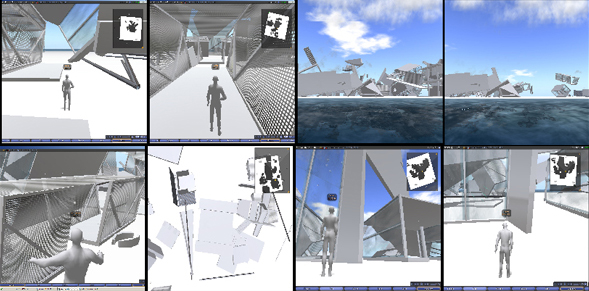
Auf der Second Life Insel „Generador hiper hibrido“ generiert ein Script fortlaufend Bauteile (Objekte) die, gesteuert durch eine Physik-Engine, auf die Insel fallen. Die Bauteile stellen wie von selbst Architektur-Agglomerationen her, fügen sich zu vielfältigen Kombinationen und Konstruktionen, kombinieren sich zu räumlichen Konfigurationen, bilden unterschiedlichste Innenräume und Abfolgen von Freiräumen; nach bestimmten Zeiteinheiten (geregelt durch die Position des Avatars zur Sensorkuppel) lösen sich einzelne Objekte auf und verschwinden wie von selbst, um später als bruchstückhafte Bauteile wieder auf die Insel zu fallen und neue Konfigurationen zu generieren. Dies passiert persistent und kann von jedem Second Life Nutzer per Avatar besucht und besichtigt werden. Die Mannigfaltigkeit der Bauteile und die Dreidimensionalität der virtuellen Umgebung bieten ständig neue Raumerlebnisse.
Die Besucher der BIACS3 sehen auf einem Screen die Insel
durch die Perspektive eines anderen Avatars. Dieser bewegt sich ebenfalls durch
ein Script – algorithmisch - gesteuert wie von selbst durch die sich ständig
verändernde und erneuernde Architektur der Insel. Die Perspektive des Avatars
(Kamera) ist so positioniert, dass er selbst nicht sichtbar ist (first-person
perspective).
Sobald ein Besucher das Feld der Installation (stellvertretend für die
Second-Life Insel) betritt, wird er von einer Videokamera erfasst und seine
Bewegungen werden per Videotracking-Verfahren umgerechnet. Der Besucher steuert
nun (anstelle der algorithmischen Bewegung) quasi analog den Avatar. Dieser
tritt ins Bild und wird auf der Insel sichtbar (third-person-perspective).
Ebenso wie der/die BesucherIn sich selbst (seine eigenen Bewegungen) steuert,
steuert er den Avatar, sowie die Bewegung seines eigenen Schattens. Zusätzlich
ist das Bild der Videokamera eingeblendet sowie das im Hintergrund laufende
Script.
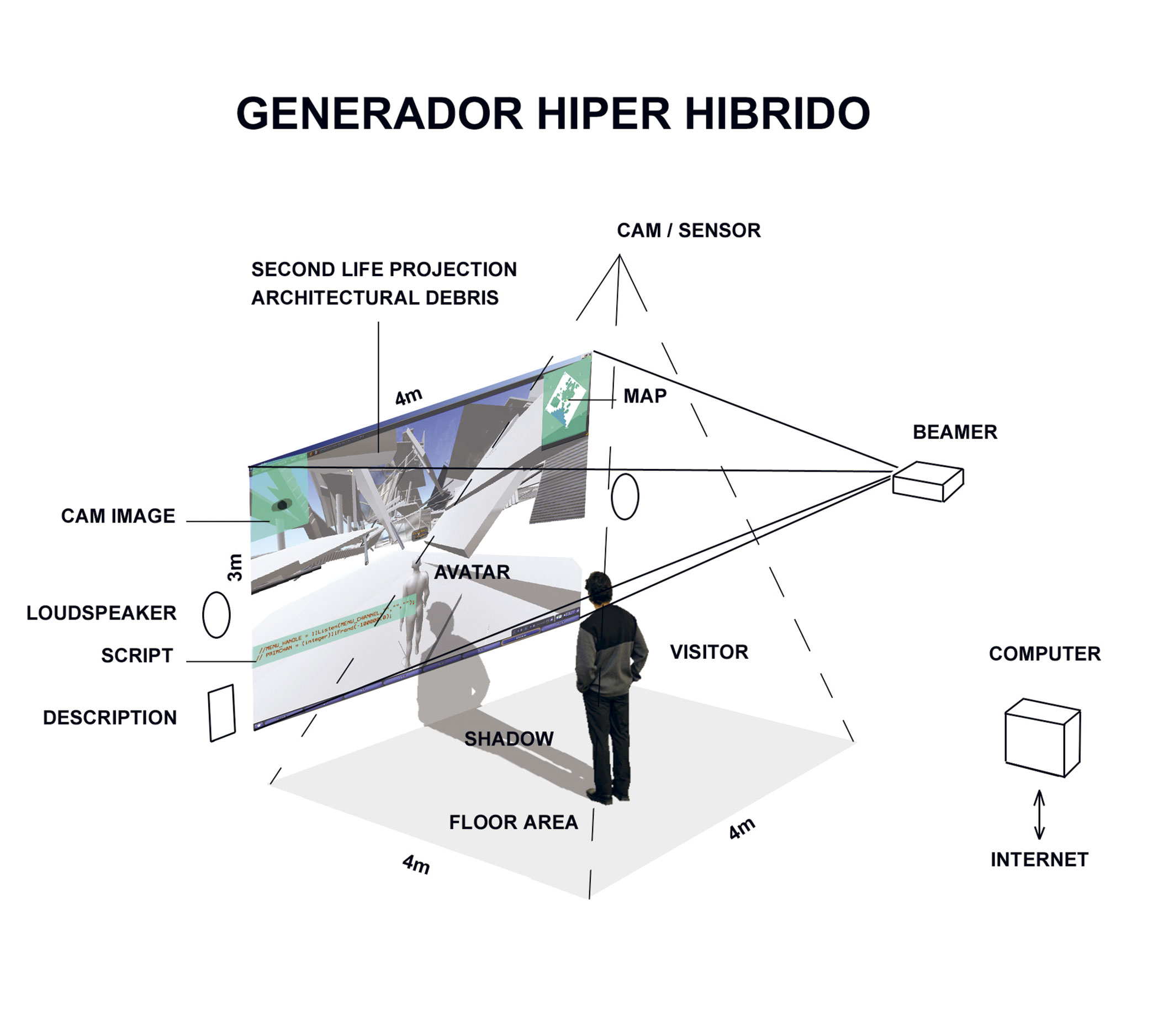
Die Installation zeigt also in einer Konfiguration simultan insgesamt fünf unterschiedliche Repräsentationen / Erscheinungsbilder / Aggregatszustände eines/r BesuchersIn im Second Life.
Die Architektur ist überall per Internet zu erleben. Sie ist ein fortlaufendes Script mit Handlungsanweisungen an den Computer (anstelle einer Baufirma). Der Genius Loci ist der Computer, erfahrbar virtuell durch ein Alter Ego. Besucher werden zum Cursor; sie sind Teil der Installation, sei es als Besucher der Ausstellung in Sevilla oder als Avatar im Second Life. Reale und virtuelle Erscheinungsformen beginnen sich zu überlagern.
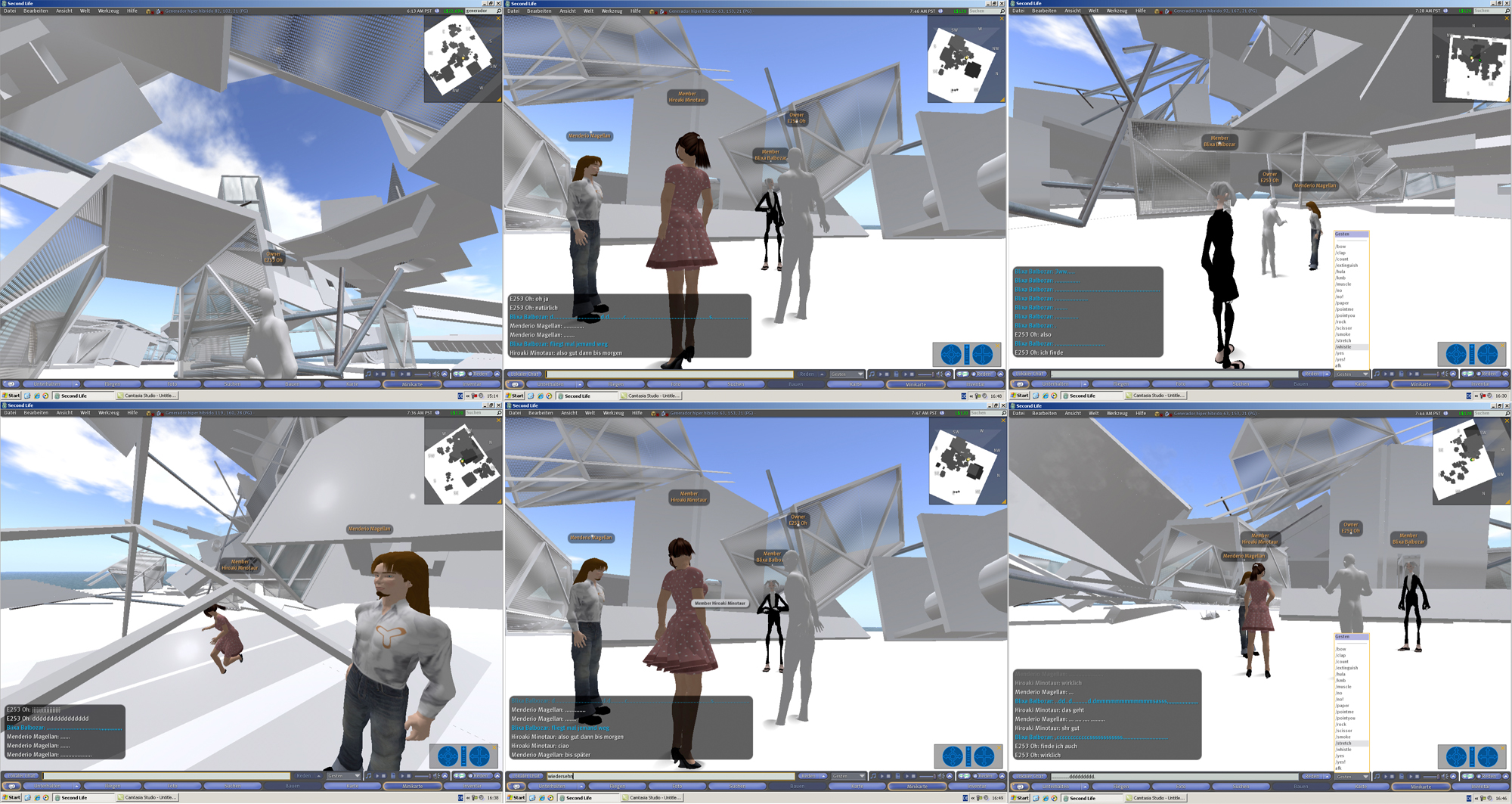
Avatare im Youniverse … Interaktion in der Planung
Technische Beschreibung
Der Hyper_Hybrid_Generator ist ein web-basiertes
ständig fortlaufendes Script des Multi-User Virtual Environments von Second Life
(SL). Es nutzt dabei die Programmiersprache von SL und schafft eine neue Art des
Morphings: es simuliert herkömmliche architektonische Entwurfsprozesse, in denen
für gewöhnlich Bruchstücke von Erinnerungen/Wünschen/Traumbildern die Triebfeder
für neue Architektur bilden.
Das Script des Hyper_Hybrid_Generators generiert architektonische Hybride. Durch zufälliges Auswählen und zufälliges Zusammenstellen unterschiedlicher Elemente (Input) wird das Ergebnis hybrid. Der Input kann aus architektonischen Bruchstücken bestehen, welche auf die virtuelle Insel fallen:
| for( i = (integer)llFrand(giMax - giMin) +
giMin; i >= 0; i-- ) { objName = llGetInventoryName(INVENTORY_OBJECT, (integer)llFrand(i)); llRezObject(objName, vThisPos, ZERO_VECTOR, <llFrand(360.0),llFrand(360.0),llFrand(360.0),llFrand(1.0)>, giSyncID);} |
Aus einer großen Anzahl von architektonischen Projekten werden durch ein Script zufällig einzelne Bruchstücke generiert. Diese werden als eine Einheit unter dem „Eltern-Script“ auf der Insel platziert und erhalten eine zufällige Drehung.
| state_entry() { gintHandle = llListen(gintPrimChan, gstrCommander, NULL_KEY, ""); llSetStatus(STATUS_PHYSICS,1); } |
Nach seiner Entstehung wartet das „Kind-Objekt“, um auf Anweisungen des Eltern-Scripts, wie z.B. auf die in SL integrierte Physik Engine, zu reagieren (es fällt herunter).
| integer iHops =
llAbs(llCeil(llVecDist(llGetPos(), gvDestPos) / 10.0)); for( x = 0; x < iHops; x++ ) lParams += [ PRIM_POSITION, gvDestPos ]; llSetPrimitiveParams(lParams); |
Das Kind-Objekt kalkuliert die Kollisionsdaten mit der simulierten Insel oder anderen Objekten und berechnet den Fallweg.
| if (gvDestPos == llGetPos()) llSetStatus(STATUS_PHYSICS,0); |
Kommt das Objekt zur Ruhe, verliert es die Fähigkeit auf die Physik-Engine zu reagieren, um nicht durch weitere Einflüsse bewegt zu werden und wartet darauf gelöscht zu werden.
Resumee:
Der traditionelle Planungsbegriff: pragmatische
Zieldefinition, das auratische Objekt, das schöne Gebäude, die Optimierung, die
Spezialisierung, autokratische und deterministische Verfahren sind nicht länger
state of the art. Es ist naheliegend, daß die aktuellsten Entwicklungen in
Wissenschaft und Technik auch für das relativ langsame Medium Architektur
aktiviert werden.
Architektur als Informationsverarbeitung, auf einer offenen
Kommunikations-plattform, eine Fülle an neuen Planungsansätzen, die operativ,
methodisch und systemisch.
Das Institut für Architektur und Entwerfen, Abteilung für Gebäudelehre und
Entwerfen sieht in der Neudefinition des Funktionsbegriffes und der
Planungsmethoden einen Schwerpunkt, die Simulation und 3D-Modellierung sind die
grundlegenden tools.
The Institute of Architecture and Design, Department of
Building Theory and Design analyses current developments in architecture by
means of computer-aided design, putting a main focus on functions. By applying
higher-level methods using web-based information and communication technology
during the planning process, on the one hand new architectures are produced in
the design stage, whilst on the other hand an innovative and more comprehensive
approach to computer-based methods in architectural planning is developed. The
basic principles of architecture algorithms on the technological planning level
are thus extended to include the end user scripting. Architecture, computer and
www are regarded as being equal information processing media. They are
information editors.
The theory related to this management of planning was published in “HYBRID
ARCHITECTURE AND HYPERFUNCTIONS” (Passagen Verlag 2006). The installation HYPER
HYBRID GENERATOR was developed by Manfred Wolff-Plottegg and Jochen Hoog
(Faculty of Architecture) together with the programmers Lukas Ofner and Johannes
Sperlhofer (Faculty of Informatics) and was presented for the first time at the
Biennale in Seville 2008. 3D modeling, self-regenerative random architecture is
constantly generated on the Second Life platform. The potential of Second Life
as a communication platform simulates beyond normal visualisation and surfing.
The extended planning environment:
Planning is the name of the game: planning
procedures, planning methods, basic planning principles, planning management,
planning of the nth order, the planning of the planning and thus project
monitoring.
Traditional planning strives to serve the assignment of requirements >
fulfilment; a predetermined spatial programme is followed by the fulfilment of
functions. Every linear assignment goes with an encapsulated function!…the
kitchen is for cooking…the bed in the bedroom is for sleeping…the flat in the
housing estate …the vacuum-cleaner for cleaning …The specified target definition
has to comply with an optimised implementation ruling out any deviations. This
planning behaviour is determinist; today’s planning > tomorrow’s concreting > to
be utilised as long as possible (sustainability). That architecture of rigid
elements (of forms, proportions and suitability) and function separation
corresponds to the above paradigm.
Reality of everyday use, constant change in requirements and shifts due to
economic frame conditions, make insisting on former decisions obsolete. What is
needed, is an architecture of mutation and the potential of a
process-controlling architecture. An architecture of processes no longer defines
deterministic objects, but simulates developments, chains of functions,
permanent changes.
The perspective in architectural project management, especially the Theory of
Function, has been newly contextualised, changed and opened up. After the
paradigm shift from determinism to an open system, architecture is not so much
involved with itself (function fulfilment, material, and form), but rather
operates with planning processes and interprets architecture as being
process-oriented. The product / object element / building is relativized and the
proceeding itself (production methods, inclusion of the producers, the users and
the extended fields of reference) is redesigned in a process-like way. Instead
of optimising spaces for a specific function, a building is organised as a
capacity building. Capacity buildings react to the reality of a constantly
changing use. This would mean that the main focus would lie on hybrid
utilisation in its architectural function, instead of on rigid buildings.
Today, even urban development is forced to deal with process control. Architecture is no longer a building or an object; urbanism is no longer a function, but an organ. We can promote the aspect of architecture as a medium (up to now very slowly) and as a process in a specific way, thus creating architecture of acceleration. We shall then realise that this kind of purported architecture has little to do with personal preferences (in harmony with belly and brain), but rather with “external” procedures and more global system variables: product > tool > tool- machine > program > program control > system control.… After cause and effect > participation and interaction > basic principles, paradigms > subsystems, system changes, system planning > open systems.
From linear planning to networking ......

Non-sequential reading – after linearity, tree structures, closed loops, feed back loops, fractals, chaos, self-generating systems are now available, beyond process control, architecture of avatars, the vision of autocatalytic components:
from determinist target definitions to open systems
from buildings to variable utilisations
from variation of form to variation of function
from autocratic planning to interconnected autocatalytics
from predefined economically planned regimes to democratic participation and further to an interactive multiplayer interface
from passive users to active planners
from typologies to procedures
from objects to processes (from pictures to films)
from planning of a finished status to planning of development potential
from buildings to process architecture and further to process control
from separation of functions to networking and further to hybrids
from specialisation to variability / flexibility to buildings at the disposal
from monofunction to multifunction and further to hyperfunction
All these developments are based on the new system theories of the 20th Century – cybernetics, fractals, chaos, fuzzy logics, game of life, constructivism, complexity, surplus, autopoiesis, etc. – which accompany the paradigm shift. On the operative level, the computer serves as an instrument, especially in planning architecture by means of new display technology, CAD and animations for simulation and parameterisation, by exemplary random generation. LAN, WAN and www networks grant access to new communication platforms.
Architecture, science, technology, media:
Drawing techniques have always exerted an influence on architecture; the central
perspective determined the dominance of the front main façade in the Renaissance
Period, and later on, following the two-point-perspective, the side façade
became more important. Today, the splines and the nurbs determine free form
geometry with bubble and blob architecture in its wake. Scientific results too,
have always had an influence on architecture: Johannes Kepler discovered the
laws of elliptic planetary motion and shortly afterwards, the first elliptic
domes were built ….
After the eclectic canon of styles and the reduction to the narrow vocabulary of form of the Classical Modern style, computer-generated form-finding changed architecture in a revolutionary way; form follows function has become obsolete. Over the past 25 years, we have proved that we can generate all kinds of forms. All forms are being built: high rises like cucumbers or ice lollies – independent of their function. In order to integrate uses & functions into planning more closely, a further feature of CPU (central processing unit of the computer), information processing and process control, can be activated. After generating forms for architecture, the utilisation procedures are then to be controlled. To steer architecture away from formal design, it is necessary to regard planning as information processing; architecture is an information editor. By applying new technologies and operative process control, architecture returns to its origins in science and technology.
Architecture as information processing:
Electronic telematic communications override local correlations. People are
constantly using their mobile phones or surfing on the web, regardless of
personal presence and/or local circumstances. The presence of different spheres
of reality is represented by binary streams of signs (bit strings) acting as a
vocabulary for communication – interconnecting neurons as well as computers.
Information and visions and ideas about the real world and the world in our
brain, as they are actually encoded by biological organisms, and the world of
digital data processing are interconnected by information processing as a common
denominator. Generating images, spaces or architecture must no longer be done
manually, mentally or anthropocentrically / expressionistically, because this
can be carried out on a data processing / data manipulation level. The exclusive
handling of classic elements like columns, walls or ceilings for the purpose of
controlling utilisation is transferred into the software sphere.
|
|
The www in particular, as a non-target-oriented,
collective generator of information, changes the disposability and
structure of information; the changed potential controls communication
and work procedures. So this appears to have a stronger influence than
the Theory of Interfaces. It is not the input (individual will), but the
procedure that influences the output. Architecture has always been a
global medium, its function being – comparable to electronic media – an
operative system to control functions. Hybrid architecture is to be understood as a self-organised process-orientated planning system for self-organised process-controlling architecture. This planning method is thus www-adequate and corresponds to today’s information processing (access and processing) … it works at high speed and is non-selective … and is an extrinsic procedure for the planner, but as far as the system is concerned, it is intrinsic … it has versatile logics … has contingency as a consequence of the hybrid combinatorics … is quasi a compiler language … the operating system of hybrid architecture. |
Communication platforms:
The internet provides manifold possibilities of communication: www
(hypertext documents), e-mail (asynchronous, private), chat (synchronous,
conference), forums (multidirectional, public), blogs (monodirectional, public),
VoIP (voice) and video conferences (image).
The developments of web 2.0 like for example “social networking” (facebook,
StudiVZ, Xing or Twitter) and personalised internet (delicious, netvibes, google
applications, flickr and youtube) offer openly designed interfaces (api’s –
Application Programming Interfaces). Here the democratic basic principle of the
web is evident.
A major characteristic of modern communication is the openness of its
communication platforms. Information flow is no longer mono or bi-directional
and does not distinguish between author and user. Everyone can be a player or a
planner, a quasi avatar as part of the system. Nobody is passive. Data exchange
is multiple (networking); everyone can upload and download – multiplayer media.
The autocratic privilege is followed by interaction, participation and
democratisation of communication; we are in the “youniverse”. Multi-user virtual
environments (MUVE) or massive multiplayer online role playing games (MMORPG)
sum up those communication technologies and position them as three-dimensioned
entities in a virtual world.
Computer games play a major role as a driving force for technological
developments (hard and soft). They provide three-dimensional worlds. The
3D-visualisation in cyberspace is one of the reasons for its success as a mass
medium (media hype). The initially envisioned virtual playground is now fully
acknowledged and used as a space where events and social contact take place. The
virtual world of telematic communication is as real as Ludo.
Second Life unites the world of www and games. In this
virtual world, everyone can additionally and actively build and change
three-dimensionally, can work on spatial design individually or on a
collaborative basis. Basic features of the “real world” can be activated and
properties (behaviour) can be added via scripting. Second Life is a virtual
three-dimensional online platform that enables thousands of users (e.g. 55.275
users on 29/1/2009) to come together at one virtual place. Currently, the
software offers the most stable and accepted multi-user virtual environment,
free of charge. The reasons for this are its good usability (user-friendly), its
balance of graphical display and transmission speed (realism versus spectrum).
Last, but not least, it is possible to visit the same 3D-world together with
other users, even with different identities.
The architect no longer has the sole autocratic planning privilege; everyone can
intervene in the real world of Second Life.
Architecture generators:
The Hyper Hybrid Generator is the latest product
of a series of architecture generators. Its development is based on the shift of
conceptual design away from the personal stimulus (brain, handwriting, will to
create) to algorithms. Random controlled processes, data processing and data
manipulations produce architecture ….. tirelessly, constantly producing new
configurations, a plenitude of various designs, exchangeable and freely
accessible. Free interpretability is placed on an equal level with free
usability (at the disposal).
|
|
|
|
Analog Architecture Generator 1987 |
Digital_Architecture_Generator 1990 |
|
|
|
|
Neuronal_Architecture_Generator 1999 |
Hyper_Hybrid_Architecture_Generator 2008 |
Hyper Hybrid Generator:
3D-Modeling and Simulation
The basic modules of the Second Life platform control the planning process; mutual intercommunication and interaction of all planning participants and components (objects and properties). Construction takes place as a consequence of communication (interaction). Generation occurs in the background on the basis of scripting. It is not the computer but architecture itself which is the interface.

On
the Second Life Island “Generador hiper hibrido”, a script permanently generates
components (building debris) which, controlled by a physics engine, fall onto
the island. The components quasi automatically create architecture
agglomerations, connect to form manifold combinations and constructions, join up
to create spatial configurations and form different internal spaces and series
of free spaces. After certain time periods (controlled by the position of the
avatar in relation to the sensor cupola), individual elements disintegrate and
vanish spontaneously and later on fall onto the island again as fragmented
components generating new configurations. This happens persistently and can be
visited and viewed by every Second Life user per avatar. The diversity of the
components plus the three-dimensioned virtual environment permanently offer new
spatial experiences.
Visitors of
BIACS3 can see the island on the screen from the perspective of a different
avatar. This avatar also moves through a script, algorithmically controlled,
quasi automatically passing through the continuously changing and self-renewing
architecture of the island. The avatar’s perspective (camera) is positioned such
that the avatar is invisible (first person perspective).
As soon as a visitor enters the installation zone (representing the Second Life
Island), he/she is tracked by a video camera and his/her movements are captured
by means of a video tracking process. The visitor now controls (instead of the
algorithmic movements) the avatar analogously. Thus the avatar enters the
projection field becoming visible on the island (third person perspective). In
the same way the visitor controls his own movements, he also controls the avatar
as well as the movement of his own shadow. Additionally, superimposed images of
the video camera as well as the background script can be viewed.

Therefore, the installation shows a total of five different representations / appearances / aggregate states of any visitor simultaneously within one configuration in Second Life.
The thus created architecture can be experienced anywhere
by the internet. It is a continuous script with instructions for the computer
(instead of for a construction company). The genius loci is the computer itself
which can be experienced virtually by an alter ego. Visitors change into a
cursor and become part of the installation, either as a visitor of the
exhibition in Seville or as an avatar in Second Life. Real and virtual
manifestations begin to overlap one another.

Technical description:
The Hyper_Hybrid_Generator is a web-based
permanent running script embedded in the multi-user virtual environment of
Second Life (SL). It uses the programming language of SL and creates a new kind
of morphing by simulating common architectural design processes in which
fragments of memories / wishes / dream images would usually initiate new
architecture.
The script of the Hyper_Hybrid_Generator generates architectural hybrids. Hybrid results are achieved by random selection and coincidental grouping of different elements (input). The input may consist of architectural debris falling onto the island:
| for( i = (integer)llFrand(giMax - giMin) +
giMin; i >= 0; i-- ) { objName = llGetInventoryName(INVENTORY_OBJECT, (integer)llFrand(i)); llRezObject(objName, vThisPos, ZERO_VECTOR, <llFrand(360.0),llFrand(360.0),llFrand(360.0),llFrand(1.0)>, giSyncID);} |
From a large number of architectural projects individual debris are generated at random by means of a script. They are then placed on the island as a unit under the “parent script” and are subject to a random rotation.
| state_entry() { gintHandle = llListen(gintPrimChan, gstrCommander, NULL_KEY, ""); llSetStatus(STATUS_PHYSICS,1); } |
After its generation, the “child object” awaits instructions from its “parent script”, like for example from the physics engine integrated in SL, to which it reacts (it falls down).
| integer iHops =
llAbs(llCeil(llVecDist(llGetPos(), gvDestPos) / 10.0)); for( x = 0; x < iHops; x++ ) lParams += [ PRIM_POSITION, gvDestPos ]; llSetPrimitiveParams(lParams); |
The child-element computes the collision data together with the simulated island or other objects and quantifies the path of fall.
| if (gvDestPos == llGetPos()) llSetStatus(STATUS_PHYSICS,0); |
In order to avoid the possibility of being moved by other influences, when the element stops moving, it loses its ability to react to the physics engine and awaits its deletion.
Conclusion:
Traditional planning conceptions: pragmatic target definition, auratic objects,
beautiful buildings, optimisation, specialisation, autocratic and determinist
processes are no longer state of the art. It is therefore obvious that the
latest developments in science and technology should be exploited for the
relatively slow architecture medium.
Architecture seen as information processing, taking place on an open
communication platform with a plenitude of new planning approaches, is becoming
operative, methodical and systemic.
The Institute of Architecture and Design, Department for Buildingscience and
Design is focusing on the redefinition of functions and planning methods,
simulation and 3D-modeling are basic tools.
3rd
INTERNATIONAL BIENNIAL OF CONTEMPORARY ART OF SEVILLE
(SPAIN)
2 October 2008 - 11 January 2009
The third
Biennial of Contemporary Art of Seville (Biacs3), to be held from 2 October 2008
to 11 January 2009, invites visitors to view this autumn’s greatest showcase of
contemporary creation under the title ‘youniverse.’ Art, science, technology,
architecture and the environment come together in a macro-exhibition that
branches out from its headquarters in Seville to the city of Granada and
features the creations of over 150 artists from around the
world.
'youniverse' is a project based on the interactivity of each
individual with the universe. The visitor will be invited to interact with its
contents to discover a new universe of which he/she will be a part. The public
will be the protagonist.
Peliminary opening Program for the 3rd
International Biennial of Centemporary Art of
Seville:
·
Press Preview in Sevilla:
Wednesday, 1st October 2008.
Press
Conference in Seville and guided visit to the exhibitions in the Andalusian
Centre of Contemporary Art (11:00 - 14:00
am.)
Visit
to other exhibition sites in the city of Seville (05:00 - 07:30 pm.)
·
Official Opening of the Biacs3
in Seville: Thursday, 2nd October 2008. 12:00 am.
·
Official Opening in Granada:
Friday, 3rd October 2008. 12:00 am.
Open doors at the CAAC
(from the 3rd till the 5th of October; Friday 10 am - 8 pm / Saturday: 11 am - 8
pm / Sunday: 10 am - 3 pm).
Curatorial Team
Peter
Weibel, general director of the ZKM Centre for Art and Media of Karlsruhe,
Germany.
Wonil Rhee, guest curator of PS1MoMA 2009, Korean
curator.
Marie-Ange Brayer, director of the Regional Centre of Contemporary
Art of Orleáns,
France.
Artists
SEVILLA
CENTRO
ANDALUZ DE ARTE CONTEMPORÁNEO (CAAC)
Airang Kang (Korea) / Alessandro Scali
& Robin Goode (Italy) / AMID (cero 9) (Cristina Diaz Moreno y Efren Garcia
Grinda. Spain) / Andrei Ujica (Rumania) / Antoni Abad (Spain) / Antonio Barrese
(Italy) / Archigram (Peter Cook. U.K.) / Archizoom Associati (Andrea Branzi.
Italy) / Atelier Hitoshi Abe & Masahige Motoe (Japan) / Axel Killian (USA /
Germany) / Bas Princen (Netherlands) / Bill Viola (USA) / Brümer, Ramakrishnan
& Weibel (Germany) / Carlo Ratti Associati (Italy) / Chen Wen Ling (China) /
Choi Sun Myung (Korea) / Christa Sommerer & Laurent Mignonneau (Austria) /
Christoph Höschele (France) / CHS Arquitectos (Spain) / Claude Parent (France) /
CLOUD 9 (Enric Ruiz-Geli. Spain) / Concha Jerez y José Iges (Spain) / Coop
Himmelb(l)au (Austria) / Curro González (Spain) / Dionisio González (Spain) /
Dora García (Spain) / EcoLogicStudio (Claudia Pasquero & Marco Poletto.
U.K.). / Electronic Shadow (Naziha Mestaoui & Yacine Ait Kazi. France) /
Elio Caccavale & Id-lab (Stefano Mirti, Line Ulrika Christiansen, Fabio
Mennella. Italy) / Emergent Architecture (Tom Wiscombe. USA) / EZCT
(Philippe Morel, Jelle Jeringa & Félix Agid. France) / Eugenio Ampudia
(Spain) / EVRU (Spain) / Francisco Almengló (Spain) / François Dallegret
(Canada) / Frederic Baker (Austro-British) / Gianni Pettena (Italy) / Giselle
Beiguelman (Brazil) / Giuliana Cunéaz (Italy) / Gregor Eichinger (Austria) /
Golan Levin y Zachary Lieberman (USA) / Gonzalo Puch (Spain) / hackitectura.net
(Spain) / Ian + (Italy) / Informationlab (Auke Touwslager, Ursula Lavrencic.
Holland) / Jakob + MacFarlane (Dominique Jacob & Brendan MacFarlane. France)
/ James Law Cybertecture (China) / Joan Fontcuberta (Spain) / Jones Partners
Architecture (Wes Jones. USA) / José Maria Mellado (Spain) / Jesús Palomino
(Spain) / Juan Carlos Robles (Spain) / Jurgen Mayer H. (Germany) / Ki Bong Rhee
(Korea) / Kisho Kurokawa (Japan, 1934 - 2007) / Kol/ Mac LLC (Sulan Kolatan
& William MacDonald. USA) / Konic thtr (collective. Spain) / Kurt Hofstetter
(Austria) / Kyung Ho Lee (Korea) / Lillian Ball (USA) / Mahmoud Khaled (Egypt) /
Manfred Wolff-Plottegg (Austria) / Manolo Bautista (Spain) / Marc Lee
(Switzerland) / Marcel Li Antunez (Spain) / Markus Huemer (Germany) / Martín
Bonadeo (Argentina) Martin Walde (Austria) / Masaki Fujihata (Japan) / Mathias
Gommel & Peter Weibel (Germany) / MATERIALECOLOGY (Neri Oxman. USA) /Matthew
Ritchie (USA) / MGM (Morales, Giles, Mariscal, Esther Pizarro y
hackitectura.net. Spain) / Michael Sailstorfer (Germany) / Michael Schuster
(Austria) / Monika Fleischmann / Wolfgang Strauss (Germany) / Moon Beom
(Korea) / Mushon Zer-Aviv (USA) / Nam June Paik (Korea) / NOX (Lars Spuybroek.
Holland) / CEAN (Michael Henses & Achim Menges. U.K. / Sweden) / Oh
Yong-Seok (Korea) / ONL (Oosterhuis_Lénard. Holland) / OSA – Open Source
Architecture- (Eran Neuman, Aaron Sprecher, Chandler Ahrens. Israel/ USA) / OSS
- Open Source Space (Ángel Borrego Cubero. Madrid, Spain) / Osvaldo Romberg
(USA) / Paul De Marinis (USA) / Peter Campus (USA) / Philip Pocock (Canada),
Yunjun Lee (South Korea), Jayoung Bang (South Korea), Alex Wenger (Switzerland),
Julian Finn (Germany / U.K.), Daniel Burckhardt (Switzerland), Linus Stolz
(Germany), Lorenz Schwarz (Germany) y Markus Zielke (Germany) / Philippe Rahm
(France) / PIPS: Lab (collective. Holland) / Rafael Lozano-Hemmer (Mexico) /
Ramón Guardans (Spain) / Raquel Renno & Rafael Marcheti (Spain/ Brazil) /
Reactable (Spain) / RobotLab (Germany) / Roland Baladi (France) / Rosalie
(Germany) / Ruth Schnell (Austria) / R&Sie (n) (Francois Roche, Stéphanie
Lavaux. France) / Sangkyoon Noh (Korea) / Sang Nam Lee (Korea) / SCENOCOSME
(Grégory Lasserre / Anais met den Ancxt. France) / SERVO (Chris Perry, Ulricka
Karlsson, Marcelyn Gow. USA) / Sergio Prego (Spain) / Shi Jinsong (China)
/ Shilpa Gupta (India) / Steina (USA) / Stephan von Huene (USA, 1932 –
Germany, 2000) / Susan Hefuna (Egypt) / Tamás Waliczky (Hungary) / Tim Macmillan
(Germany) / Tom Kovac (Australia) / Tom Verebes (U.K.) / Toyo Ito (Japan) /
Vicente Guallart (Barcelona, Spain) / Wolfgang Munch (Germany) / Wu Ming Zhong
(China) / Xefirotarch (Hernán Díaz Alonso. USA) / Yang Qian (China) /
Zbigniew Rybczynski (Poland)
SEVILLA (Exteriors)
Jenny
Marketou (USA) / Loove Broms, Milo Lavén, Erik Krikortz (Sweden) / Michael
Bielicky (Germany) / Mischa Kuball (Germany) / Steve Bradley
(Germany)
GRANADA
PALACIO CARLOS V.
ALHAMBRA
Adel Abdessemed (Algeria) / Airang Kang (Korea) / Bill Viola (USA) /
Bong-Chae Son (Korea) / Choi Sun Myung (Korea) / Dave Griffiths (UK) / Eli Gur
Arie (Israel) / Eugenio Ampudia (Spain) / Jeffrey Shaw (Australia) / Ki Bong
Rhee (Korea) / Lee Nam Lee (Korea) / MEDRAR (Egypt) / Noh Sang-Kyoon (Korea) /
Olafur Eliasson (Denmark) / Shao Kang (China) / Shi Jin Song (China) / Shi-il
Kim (Korea) / Susan Hefuna (Egypt) / Xu Zhong Min (China) / Yasuhiro Suzuki
(Japan) / Yong Ho Ji (Korea)